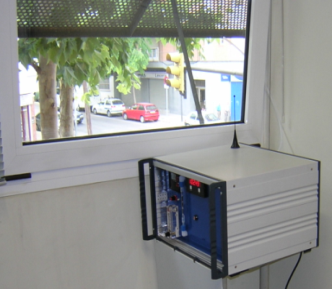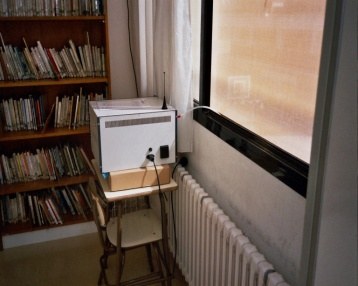Indoor air quality
INDOOR AIR. AIR QUALITY EVALUATION
The following services related to indoor air quality evaluation are available at LCMA:
- Sick building syndrome (SBS) evaluation through EU recommended criteria. Determination of Total volatile organic compounds (TVOC) and distribution of VOC families
- Determination of pollutants in workplaces through Instituto Nacional de Seguridad e Higiene en el Trabajo recommeneded techniques
- Odour episodes control. Determination of their origin through the identification of tracer compounds determined by chemical control
- Generation of databases for atmospheric pollution risk evaluation
- Ventilation Systems evaluation. Continuous recording of temperature, relative humidity, CO, CO2, SO2, NO, O3, and TCOV. Simulation (LCMA model) of CO2 concentration evolution depending on design parameters and metabolic activity. Ventilation systems certifications
- Air purifying systems evaluation: sorbents, photocatalytic, …
APLICATION FIELDS
The applications of the above mentioned services in real scenarios have been the following:
- Identification of odorous/nuisance episode generating compounds in dwellings (internal and external sources)
- Identification of VOC in dwellings with multiple chemical sensibility inhabitants
- Identification of pollutants in the indoor air of research centres (laboratories)
- Evaluation of ventilation systems in gyms, laboratories, etc…
- Design evaluation of clean atmosphere areas (bubble 99.995% free of particulate phase)
- Indoor air quality evaluation in motorhomes (TCOV, COV, CO2, CO, formaldehyde). Evaluation of construction materials emissions, ventilation systems design.
|
INTERNAL AND EXTERNAL SOURCES IMPACT EVALUATION
Odour and nuisance situations that affect the inhabitants of a concrete dwelling can be caused by external and/or internal sources. To diminish effectively their impacts, their source determination is a crucial point. Chemical control is the most effective technique to obtain this goal, using both continuous and discontinuous sampling methodologies.
Examples of the impact of internal sources on indoor air quality
In figure 4, carbon dioxide concentrations in a indoor cycling room with a deficient ventilation ratio can be seen. CO2 levels are higher than 2800 ppm.
Figure 4. CO2 concentration evaluation in a indoor cycling room |
Figure 5 shows the application of an appropriate ventilation flow rate depending on the volume of the room, the metabolic activity category and the occupation of the room (maximum number of persons). With this practical application, relevant reductions of CO2 increases can be achieved.
LCMA has developed an air quality simulation software (CO2 concentration variation) based on ventilation systems design parameters (figure 6).
metabolic activity stages. CO2 concentrations obtained when using an air quality control design. |
space occupation (number of persons), the flow rate ventilation, the room volume and the kind of metabolic activity developed in the room (LCMA model) |
Figure 7 presents the evaluation of the ventilation system in a transportable purified air system (Zonair3d: www.zonair3d.com)
Figure 7. CO2 concentration evaluation depending on the ventilation system design |
||||
Constructive materials have an important role in indoor air quality due to their emission of VOC indoors. The knowledge of the emission from different constructive materials is a key point when taking the decision of which ones to use, as well as are important in the design of the ventilation system.
VOC indoor concentrations in a new motorhome (figure 8) are presented in Table 2.
Figure 8. Air quality control in motorhomes. TVOC, VOC, CO2 and CO controls. |
VOC concentration levels of the compounds that are toxic, irritant and can induce odorous nuisance in a motorhome indoor air are presented in table 2. The rest of COV are quantified with the response factor of toluene, and the TVOC value is given.
|
Table 2. VOC indoor concentration levels in a motorhome
|
Example of the impact of an external source on indoor air quality
Several quality criteria are applied to determine the indoor air quality in a dwelling that is impacted by external emissions:
Quality criteria
a) Total Volatile Organic compounds (TVOC) referenced in reports Nº 11 and 19 of the European Commission (European Collaborative Action. Indoor Air Quality & its Impact on Man. EUR 17675 EN and EUR 14449 EN):
TVOC
Comfort range: < 200 µg/m3
Multifactorial exposure range: 200–3000 µg/m3
Discomfort range 3000 – 25000 µg/m3
Toxic range: > 25000 µg/m3
b) Maximum familial concentrations in an indoor air according to (Seifert, 1990):
(*) excluding formaldehyde |
c) Individual compounds
- No individual compound should exceed 50% of the average value of its class
- No individual compound should exceed 10% of the measured TVOC value (300 µg/m3)
d) Formaldehyde guide value Report Nº7 European Commission (European Collaborative Action. Indoor Air Quality & its Impact on Man. EUR 17675 EN and EUR 14449 EN)
e) ESL values (Effects Screening Levels) published by the Texas Commission on Environmental Quality. No effects on human health and comfort are expected below these values. ESL values are given for individual VOC for short and long exposition times.
|
Table 3. VOC concentrations in a dwelling impacted by external sources
|
In the example presented in table 3 can be seen that the familial percentages are considerably different from the recommended values (criterion b). High concentrations of several VOC (e.g. ethanol, isopropanol, acetonitrile and acetic acid) alter the familial distributions.
Bibliography
- Gallego, E., Roca, F.J., Perales, J.F., Guardino, X., Berenguer, M.J., “Determining indoor air quality and identifying the origin of odour episodes in indoor environments, Journal Environmental Sciences, 21, pp.333-339 (2009)
- Gallego, E., Roca, F.J., Perales, Guardino, X.,” Assessment of chemical hazards in sick building syndrome situations. Determination of concentrations and origin of VOCS in indoor air environments by dynamic sampling and TD-GC/MS analysis”, Springer, ISBN 978-3-642-17918-1p. 289-334, (2011)
- Gallego, E., Perales, J.F., Roca, F.J., Guardino, X., "Experimental evaluation of VOC removal efficiency of a coconut shell activated carbon filter for indoor air quality enhancement". Building and Environment (2013)

















Share: